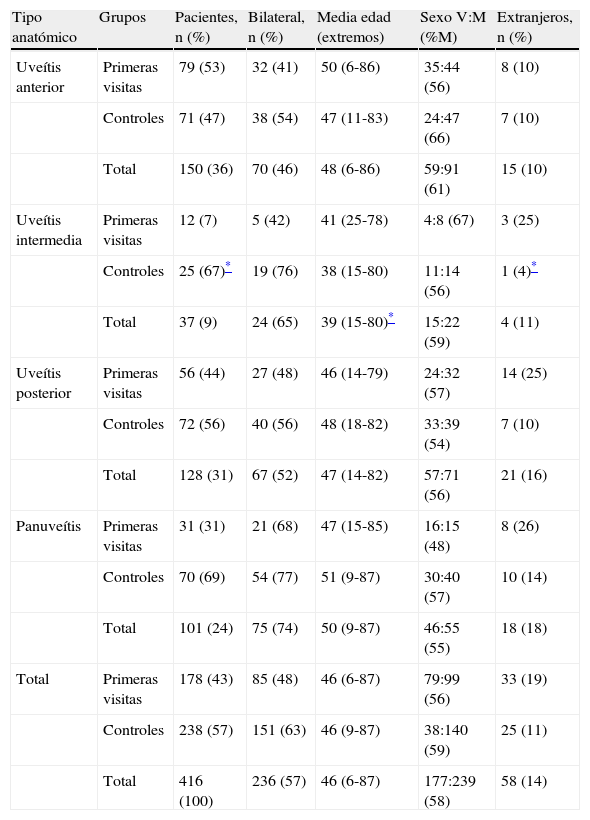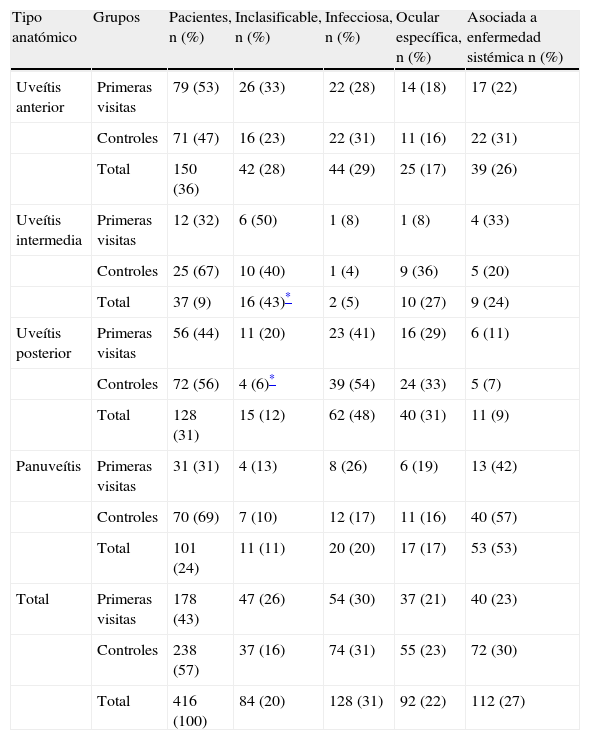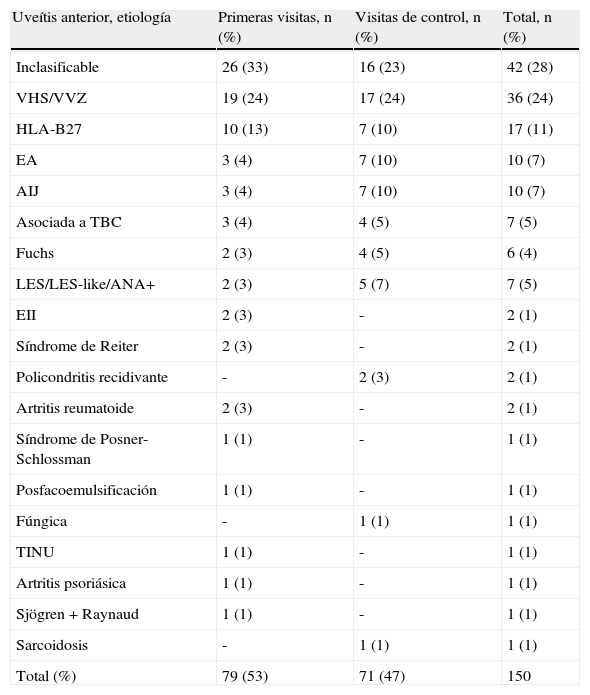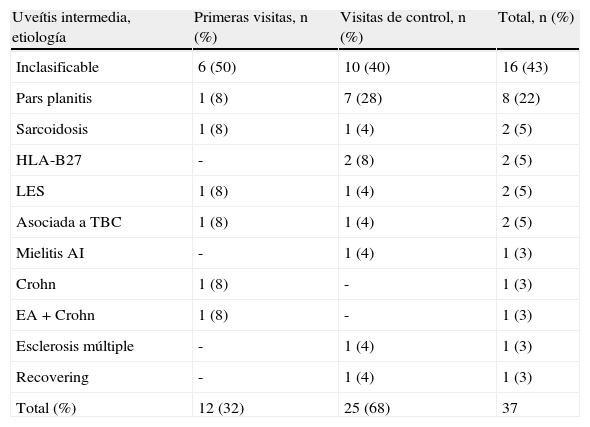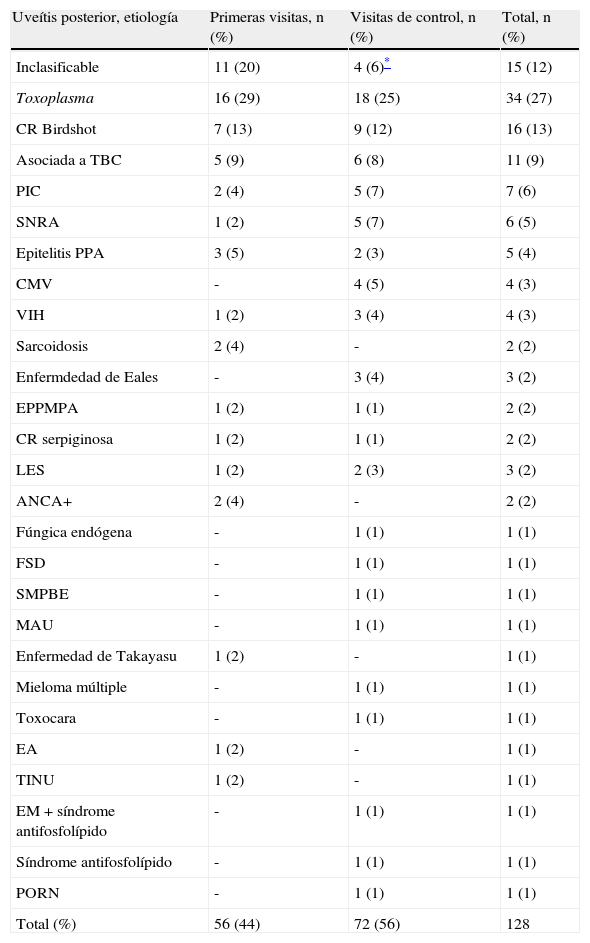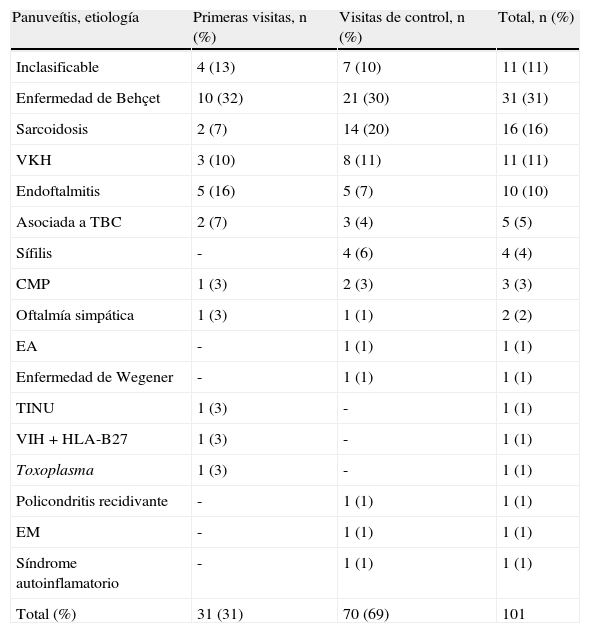Conocer el patrón uveítico de nuestra área geográfica. Los recientes cambios demográficos, ecológicos y científicos pueden determinar cambios epidemiológicos en las uveítis, que nos hemos propuesto investigar.
Pacientes y métodoCorte transversal desde el 1-01-2009 al 30-06-2010. Se incluyeron todos los pacientes atendidos por uveítis en nuestro centro. Se analizaron el tipo anatómico (IUSG & SUN), la etiología (tests «a medida»), la edad, el sexo, la procedencia y la lateralidad. Los resultados entre las «primeras visitas» y los controles fueron comparados estadísticamente mediante los tests de ANOVA y ji al cuadrado.
ResultadosDe 416 pacientes incluídos, 150 (36%) fueron uveítis anteriores, 128 (31%) posteriores, 101 (24%) panuveítis y 37 (9%) uveítis intermedias (UI). Un 56% (236) fueron bilaterales, la edad media fue de 46 años (extremos 6-87) y un 58% fueron mujeres. El 14% (58) fueron pacientes extranjeros. Por etiología, un 20% fueron inclasificables, un 31% infecciosas, un 26% asociadas a enfermedades sistémicas y un 23% oculares específicas. Entre las causas conocidas, la herpética (11%), Toxoplasma (8%), Behçet (8%) y tuberculosis (6%) fueron las más frecuentes. Las UI afectaron significativamente por primera vez a más extranjeros (p=0,018), afectaron a pacientes más jóvenes (p=0,008) y fueron más frecuentemente crónicas (p=0,003) e inclasificables (p=0,024).
ConclusiónEn nuestro medio, un 80% de las uveítis pueden ser correctamente clasificadas. Las UI han incrementado su frecuencia en población extranjera, suelen ser inclasificables y crónicas. La tuberculosis (6%) y la enfermedad de Birdshot (4%) deben ser tenidas en cuenta como causa de uveítis.
To describe the uveitis pattern in our geographic area. Recent demographic, environmental and scientific changes can determine uveitis pattern changes, which we aim to investigate.
Patients and methodsA cross-sectional study between 1st January 2009 and 30th June 2010 was done. All uveitis patients visited at our institution were included. Anatomical (IUSG & SUN) and aetiological patterns (by “tailored” tests), age, sex, origin and laterality were analyzed. Results from first visits and controls were compared statistically, by chi-square and ANOVA tests.
ResultsFrom 416 patients included, 150 (36%) were anterior uveitis, 128 (31%) posterior, 101 (24%) panuveitis and 37 (9%) intermediate uveitis (IU). Fifty-six percent (236) were bilateral, mean age was 46 years (6-87) and 58% were women. Fourteen percent (58) were from non-Spanish origin. By aetiology, 20% were unclassifiable, 31% infectious, 26% associated with systemic immune diseases and 23% were ocular specific syndromes. Among classified causes, herpes virus (11%), Toxoplasma (8%), Behçet (8%) and tuberculosis (6%) were the most common. IU were diagnosed more frequently at first time in foreign patients (P=.018); they affected younger patients (P=.008), were more chronic (P=.003) and unclassifiable (P=.024).
ConclusionIn our area, 80% of uveitis can be correctly classified. IU have an increased frequency among foreigners, and they use to be unclassifiable and chronic. Tuberculosis (6%) and Birdshot chorio-retinopathy (4%) must be kept in mind as uveitis causes.
Artículo
Comprando el artículo el PDF del mismo podrá ser descargado
Precio 19,34 €
Comprar ahora






